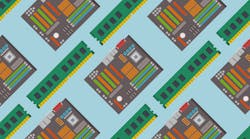Check out more coverage of DesignCon 2023. This article is also part of TechXchange: PCB Tools and Technology.
In electronic systems, electrical signals tend to travel through a wide range of different interconnects, spanning from chip to package, from package to the copper traces in the circuit board (PCB), and then eventually out through high-speed connectors.
As signals dash through a system at high speed, signal-integrity (SI) issues such as signal reflections, delays, distortion, ringing, crosstalk, ground bounce, and electromagnetic interference (EMI), among many others, can arise. If the circuit board isn’t carefully designed to counter these issues, they can scramble or degrade signals to such a degree that faults occur. The faults can cause the circuit board to malfunction or even fail.
Today, the task of testing, identifying, and resolving SI issues in a system is a serious challenge. But these issues are becoming worse as the speed of signals traveling through the PCB continue to rise and chips are bundled more tightly together. Electronics engineers also have a higher bar to clear when it comes to electromagnetic compliance (EMC), which can impact the signal integrity of other devices in the vicinity.
To lend a helping hand, Keysight Technologies introduced Electrical Performance Scan, or EP-Scan, a new high-speed digital simulation tool that promises faster SI analysis for hardware engineers. Launched ahead of DesignCon 2023, the company said the EP-Scan can handle electromagnetic (EM) simulations on signal nets and report metrics that are critical to SI, including impedance and insertion loss.
Once you finish the preliminary design of a PCB, engineers need to test and validate the quality of the signals traveling from point A to point B on the hardware before building physical prototypes. Unlike the connection lines sprawled out on the schematic of a circuit board, physical wires and other interconnects have resistance, capacitance to ground (and other wires), and inductance that can all impact signal integrity.
To root out SI issues on a PCB design, it’s necessary to run simulations on a vast number of nets—a process that can take days or weeks to complete. As a result, said Tim Wang-Lee, product marketing manager at Keysight, it has become a serious challenge to predict how long it will take to pinpoint performance issues in a design. “This uncertainty creates a bottleneck in the design cycle,” he told Electronic Design.
Faster Evaluation with EP-Scan
Keysight said EP-Scan can address these bottlenecks, giving engineers the ability to rapidly run diagnostics on a circuit board and pinpoint inconsistencies in the design prior to ordering expensive prototypes.
Rebuilding a PCB—or a prototype of one—usually costs less than redesigning one of the chips or other components packed on it. But the costs—and the impacts on time-to-market—can still be significant. On top of that, a circuit board may not malfunction until it’s deployed in a device in the field. Thus, it pays to make sure everything is designed to work right from start, before investing in prototypes of the PCB.
EP-Scan can automatically evaluate the performance of different versions of the same circuit board, identify areas for improvement in the layout of the design, and create progress reports for engineers to review.
To do its job, EP-Scan requires only the layout geometry and substrate stackup information for the PCB as inputs. After you specify what you want investigated, EP-Scan reports simulation results ranging from characteristic impedance and delay of traces to return loss and insertion loss, among other metrics. By supporting popular fabrication formats, EP-Scan shows engineers the performance of their design as it would when fabricated.
Keysight said EP-Scan helps reduce time-to-market by pointing out issues with signal integrity earlier on in the design cycle, giving you more confidence that a PCB is ready to go to prototype and then full production.
“Our goal with EP-Scan is to ‘shift left’ the PCB design verification process by using early simulation to detect and correct errors, giving hardware designers the confidence to move forward and obtain first pass success,” said Wang-Lee.
Check out more coverage of DesignCon 2023. Also, read more articles in TechXchange: PCB Tools and Technology.

